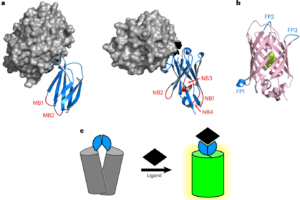
Image Copyright: Nature Methods
Adaptable, turn-on maturation (ATOM) fluorescent biosensors for multiplexed detection in cells
Published in Nature Methods (2023)
Authors
Harsimranjit Sekhon, Jeung-Hoi Ha, Maria F Presti, Spencer B Procopio, Ava R Jarvis, Paige O Mirsky, Anna M John, Stewart N Loh
Paper presented by Dr. Reinis Svarcbahs and selected by the NIDA TDI Paper of the Month Committee
Publication Brief Description
Turn-on fluorescent protein-based biosensors typically require long, painstaking engineering and cannot be easily adapted to different targets. In this paper, authors developed a single-molecule, turn-on maturation fluorescent protein-based platform that can be adapted to recognize different proteins of choice. These biosensors consist of a fluorescent protein and circularly permuted nanobody or monobody, named adaptable, turn-on maturation (ATOM) biosensors. Biosensors are based on an observation that a yellow fluorescent protein with a circularly permuted FK506-binding protein exhibited a 35-fold turn-on of yellow fluorescence with the addition of FK506 or its analog rapamycin. The authors furthered the approach by circularly permuting nanobodies and monobodies with cyan, yellow, and red fluorescent proteins. As a proof of concept, they generated circularly permuted monobody of human proteins hRAS, c-Abl Src homology 2 (SH2) domain and WD repeat-containing protein 5 (WDR5), and mCherry recognizing nanobody that are localized to different cell compartments. All sensors displayed up to 60-fold increase in fluorescence upon binding to the target in cells and more than 100-fold increase in vitro. Overall, the authors describe reagents to create a turn-on biosensor from a monobody or nanobody that recognizes your protein of interest.
Adaptable, turn-on maturation (ATOM) fluorescent biosensors for multiplexed detection in cells Journal Article
In: Nat Methods, vol. 20, no. 12, pp. 1920–1929, 2023, ISSN: 1548-7105.
